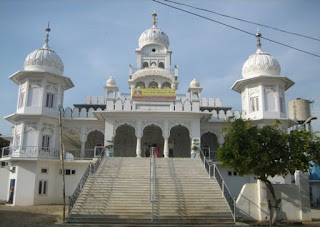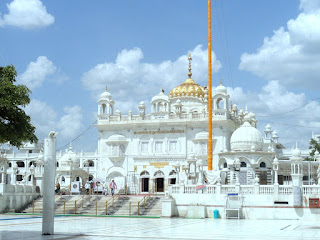Takht Sri Damdama Sahib
Damdama means the breathing or resting place. Gurudwara Sri Damdama Sahib is one of the Five Takhts of the Sikhs. It is located at village Talwandi Sabo, 28 km southeast of Bathinda. It is also known as 'Guru Ki Kashi'. Guru Gobind Singh Ji stayed here after fighting battles against Mughal atrocities. Before his arrival at Talwandi, two of the Guru’s sons were bricked alive at Sarhind and two laid down their lives at Chamkaur Sahib. After writing Zafarnama, Guru Gobind Singh fought a successful battle at Muktsar and then moved towards Talwandi Sabo Ki.
While at Talwandi, Sikhs started coming to the Guru from all over Punjab and other places. Here Takht Sri Damdama Sahib, Talwandi Sabo, Gurudwara Damdama Sahib, Damdama Tour a Gurudwara was erected in Guru's memory. This place is also known as Guru -Ki -Kanshi as it was made a center of the Sikh learning.
Damdame Wali Bir of Sri Guru Granth Sahib was prepared here by Guru Gobind Singh. It was transcribed by Bhai Mani Singh. The hymns of Guru Tegh Bahadur Sahib were added into the Bir.
It was at Dam Dama Sahib that Bhai Dalla was tested for his bravery by Guru Gobind Singh and brought into the order of Khalsa. It was from Damdama Sahib that the Guru moved towards south. In the meantime, Aurangzeb died and the Guru helped Bahadur Shah, Aurangzeb's eldest son to sit on the throne.
The Guru was honored by Bahadur Shah at Agra. The new Emperor also left for south but parted from the Guru at Nanded. It is said that Bahadur Shah did not fulfill his promise to punish the officials who had committed atrocities upon the Sikhs and killed Guru's young children. The Guru commissioned Banda Bahadur to Go to Punjab and punish the guilty and bring peace to the state.
Guru Gobind Singh arrived here on 20-21 January, 1706 and camped outside the village. The magnificent Gurudwara Sri Damdama Sahib marks the place of his stav. Here local Chaudhari Bhai Dalla looked after Guruji with great devotion. He refused to arrest the Guru as directed by Wazir Khan, Nawab of Sirhind.
Mata Sundri and Mata Sahib Kaur escorted by Bhai Mani Singh came here from Delhi to meet Guruji. Guruji spent nine months of intense literary activities.
Here Bhai Mani Singh prepared the holy volume under the guidance of Guruji. Talwandi thus became a seat of learning and assumed the status of Guru Ki Kashi. It was here that Chaudhari Tiloka and Rama, ancestors of the Pulkian (Patiala, Nabha and Jind) rulers received Amni from the blessed hands of the Guru. Sacred articles of the tenth Guru, namely Sri Sahib (Sword), a mirror, a match lock, a portrait of the tenth Guru, a pothi. (book) transcribed by Baba Deep Singh, Sword of Baba Deep Singh and a Persian sword are displayed in the Gurudwara Damdama Sahib. The other sacred place at Talwandi Sabo are, Jand Sahib, Tibbi Sahib, Likhansar and Gurusar.
Besides, there are two Gurudwaras in memory of the ninth Guru Sri Tegh Bahadur, known as Wada Darbar Sahib and Gurusar.
Guru Gobind Singh had come to Talwandi Sabo at the request of Bhai Dala, a devoted follower. He was the Chief of Brar jats of Ma!wa area. He liked the place immensely and stayed here for over nine months. During his stay, the place was transformed into abode of the Khalsa and became a second Anandpur.
At Damdama Sahib as it is now called, the Guru preached complete sacrifice of personal and family interests at the altar of the good of mankind. The following. words of the great Guru expressing his firm faith in the Khalsa, are inscribed on a pillar installed by the Punjab Government,
"To the Khalsa does belong all,
My home, my body, and all I possess"
Before leaving to visit Sikh Sangats in the Deccan, Guruji blessed Talwandi Sabo, as Guru Ki Kashi. Now known better as Damdama Sahib after the Gurdwara became one of the four temporal Takhats of the Sikh religion. Another great Shaheed (Martyr) of Sikhi, Baba Deep Singh ji was installed as the first Jathedar (head) of this temporal seat. He penned additional copies of the Adi Sri Granth Sahib ji and sent them to the other four temporal seats.
This title was given because of the intense literary activities that Guru Gobind Singh engaged in during his stay here (the compilation of Sikh scriptures). It is said that one day Guru Gobind flung a handful of reed pens over the heads of the congregation ('Sangat'), saying: "Here we will create a pool of literature. No one of my Sikhs should remain illiterate." The Damdama Wali Bir as the Guru Granth Sahib is sometimes called was completed here, being dictated by the Guru to one of his disciples Bhai Mani Singh. It was at this time when the hymns of Guru Tegh Bahadur Sahib, the ninth Guru and father of Guru Gobind Singh were added to the Bir.
Other Gurudwaras at Takht Sri Damdama Sahib are :
- Gurudwara Manji Sahib Sri Guru Tegh Bahadur
- Gurudwara Manji Sahib Padshahi Nauvin and Dasvin
- Gurudwara Likhansar Sahib
- Gurudwara Jandsar Sahib
- Gurudwara Tibbi Sahib
- Gurudwara Sri Nanaksar
- Gurudwara Niwas Asthan Padshahi Dasvin
- Gurudwara Mata Sundari and Sahib Devan
This Takht was officially recognized as the fourth Takht of Sikhism on 18 November 1966. On a demand from the Sikhs, a sub-committee was appointed by the Shiromani Gurdwara Prabandhak Committee, Amritsar by General Meeting Resolution No: 789 on 30 July 1960. A report of the sub-committee containing 183 pages was received to declare Damdama Sahib or Guru Ki Kashi as the fifth Takht of the Sikhs. A general body meeting of the Shiromani Gurdwara Prabandhak Committee at Amritsar approved the recommendations through resolution number 32 on 18 November 1966. It was declared as the fifth Sikh Takht by the government of India in April 1999 during tricentennial celebrations of the formation of the Khalsa.
While at Talwandi, Sikhs started coming to the Guru from all over Punjab and other places. Here Takht Sri Damdama Sahib, Talwandi Sabo, Gurudwara Damdama Sahib, Damdama Tour a Gurudwara was erected in Guru's memory. This place is also known as Guru -Ki -Kanshi as it was made a center of the Sikh learning.
Damdame Wali Bir of Sri Guru Granth Sahib was prepared here by Guru Gobind Singh. It was transcribed by Bhai Mani Singh. The hymns of Guru Tegh Bahadur Sahib were added into the Bir.
It was at Dam Dama Sahib that Bhai Dalla was tested for his bravery by Guru Gobind Singh and brought into the order of Khalsa. It was from Damdama Sahib that the Guru moved towards south. In the meantime, Aurangzeb died and the Guru helped Bahadur Shah, Aurangzeb's eldest son to sit on the throne.
The Guru was honored by Bahadur Shah at Agra. The new Emperor also left for south but parted from the Guru at Nanded. It is said that Bahadur Shah did not fulfill his promise to punish the officials who had committed atrocities upon the Sikhs and killed Guru's young children. The Guru commissioned Banda Bahadur to Go to Punjab and punish the guilty and bring peace to the state.
Guru Gobind Singh arrived here on 20-21 January, 1706 and camped outside the village. The magnificent Gurudwara Sri Damdama Sahib marks the place of his stav. Here local Chaudhari Bhai Dalla looked after Guruji with great devotion. He refused to arrest the Guru as directed by Wazir Khan, Nawab of Sirhind.
Mata Sundri and Mata Sahib Kaur escorted by Bhai Mani Singh came here from Delhi to meet Guruji. Guruji spent nine months of intense literary activities.
Here Bhai Mani Singh prepared the holy volume under the guidance of Guruji. Talwandi thus became a seat of learning and assumed the status of Guru Ki Kashi. It was here that Chaudhari Tiloka and Rama, ancestors of the Pulkian (Patiala, Nabha and Jind) rulers received Amni from the blessed hands of the Guru. Sacred articles of the tenth Guru, namely Sri Sahib (Sword), a mirror, a match lock, a portrait of the tenth Guru, a pothi. (book) transcribed by Baba Deep Singh, Sword of Baba Deep Singh and a Persian sword are displayed in the Gurudwara Damdama Sahib. The other sacred place at Talwandi Sabo are, Jand Sahib, Tibbi Sahib, Likhansar and Gurusar.
Besides, there are two Gurudwaras in memory of the ninth Guru Sri Tegh Bahadur, known as Wada Darbar Sahib and Gurusar.
Guru Gobind Singh had come to Talwandi Sabo at the request of Bhai Dala, a devoted follower. He was the Chief of Brar jats of Ma!wa area. He liked the place immensely and stayed here for over nine months. During his stay, the place was transformed into abode of the Khalsa and became a second Anandpur.
At Damdama Sahib as it is now called, the Guru preached complete sacrifice of personal and family interests at the altar of the good of mankind. The following. words of the great Guru expressing his firm faith in the Khalsa, are inscribed on a pillar installed by the Punjab Government,
"To the Khalsa does belong all,
My home, my body, and all I possess"
Before leaving to visit Sikh Sangats in the Deccan, Guruji blessed Talwandi Sabo, as Guru Ki Kashi. Now known better as Damdama Sahib after the Gurdwara became one of the four temporal Takhats of the Sikh religion. Another great Shaheed (Martyr) of Sikhi, Baba Deep Singh ji was installed as the first Jathedar (head) of this temporal seat. He penned additional copies of the Adi Sri Granth Sahib ji and sent them to the other four temporal seats.
This title was given because of the intense literary activities that Guru Gobind Singh engaged in during his stay here (the compilation of Sikh scriptures). It is said that one day Guru Gobind flung a handful of reed pens over the heads of the congregation ('Sangat'), saying: "Here we will create a pool of literature. No one of my Sikhs should remain illiterate." The Damdama Wali Bir as the Guru Granth Sahib is sometimes called was completed here, being dictated by the Guru to one of his disciples Bhai Mani Singh. It was at this time when the hymns of Guru Tegh Bahadur Sahib, the ninth Guru and father of Guru Gobind Singh were added to the Bir.
Other Gurudwaras at Takht Sri Damdama Sahib are :
- Gurudwara Manji Sahib Sri Guru Tegh Bahadur
- Gurudwara Manji Sahib Padshahi Nauvin and Dasvin
- Gurudwara Likhansar Sahib
- Gurudwara Jandsar Sahib
- Gurudwara Tibbi Sahib
- Gurudwara Sri Nanaksar
- Gurudwara Niwas Asthan Padshahi Dasvin
- Gurudwara Mata Sundari and Sahib Devan
This Takht was officially recognized as the fourth Takht of Sikhism on 18 November 1966. On a demand from the Sikhs, a sub-committee was appointed by the Shiromani Gurdwara Prabandhak Committee, Amritsar by General Meeting Resolution No: 789 on 30 July 1960. A report of the sub-committee containing 183 pages was received to declare Damdama Sahib or Guru Ki Kashi as the fifth Takht of the Sikhs. A general body meeting of the Shiromani Gurdwara Prabandhak Committee at Amritsar approved the recommendations through resolution number 32 on 18 November 1966. It was declared as the fifth Sikh Takht by the government of India in April 1999 during tricentennial celebrations of the formation of the Khalsa.






Comments
Post a Comment